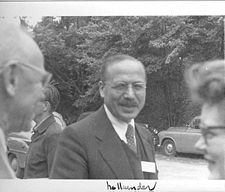
Summary
Alexander Hollaender (9 December 1898 – 6 December 1986) was one of the world's leading researchers in radiation biology and in genetic mutations. In 1983 he was given the Enrico Fermi Award by the United States Department of Energy for his contributions in founding the science of radiation biology, and for his leadership in promoting "scientific exchanges" between American scientists and scientists from developing countries.[1]
Alexander Hollaender | |
|---|---|
 Alexander Hollaender at Cold Spring Harbor Symposium, c. 1950's
Photograph by Esther Lederberg | |
| Born | December 9, 1898 |
| Died | December 6, 1986 (aged 87) |
| Known for | Radiation-induced mutations |
| Awards | Enrico Fermi Award (1983) |
| Scientific career | |
| Institutions | Cold Spring Harbor Laboratory |
Hollaender was born in Samter, German Empire (Szamotuły, Poland), he emigrated to the US in 1921.[2] In 1939 Hollaender published research showing that the mutations of spores of the ringworm fungus occurred in the same spectrum as the absorption spectrum of nucleic acids indicating that nucleic acids form the building blocks of genes.[3] A young Esther M. Zimmer, who worked with Dr. Hollaender at the U. S. Public Health Service (Bethesda, MD),[4] published with Dr. Hollaender, Eva Sansome and Milislav Demerec in this very early field of x-ray- and UV-induced mutations.[5][6] Later on, Esther M. Zimmer (now Esther Lederberg) became one of the most influential founders of bacterial and bacteriophage (Lambda phage) genetics. Later on, Hollaender worked at Oak Ridge National Laboratories with M. Laurance Morse, who himself later went on to collaborate with Esther Lederberg.
His research was not appreciated for its discovery at the time, and later scientists reports were necessary before science accepted the role of nucleic acids as the genetic material.[3] Historians of science now realize his early discovery, and his Fermi Award recognized this discovery.[1][3]
In 1981 Hollaender established the Council for Research Planning in Biological Sciences, and was its president at the time of his death from a pulmonary embolism in 1986.[7] The US National Academy of Sciences gives the Alexander Hollaender Award in Biophysics every three years in his honor.[8]
References edit
- ^ a b "The Enrico Fermi Award 1983". Archived from the original on 2009-12-22. Retrieved 2009-11-29.
- ^ Alexander Hollaender, in memoriam R.C. von Borstel
- ^ a b c von Borstel, R. C.; Charles M. Steinberg (July 1996). "Alexander Hollaender: Myth and Mensch". Genetics. 143 (3): 1051–1056. doi:10.1093/genetics/143.3.1051. PMC 1207377. PMID 8807280. Retrieved 2009-11-29.
- ^ "Esther M. Zimmer Lederberg: Professional Records".
- ^ Hollaender, A. and Zimmer, E. M., January 1945 (September, 1944), "The effect of ultraviolet radiation and X-rays on mutation production in Penicillium notatum", Genetics Society of America 30(1):8; see http://www.estherlederberg.com/Papers.html
- ^ Hollaender, A., Sansome E. R., Zimmer, E., Demerec, M., April 1945, "Quantitative Irradiation Experiments with Neurospora crassa. II. Ultraviolet Irradiation", American Journal of Botany 32(4):226-235; see http://www.estherlederberg.com/Papers.html
- ^ "Alexander Hollaender". IEEE Global History Network. IEEE. Retrieved 21 July 2011.
- ^ "Alexander Hollaender Award in Biophysics".
External links edit
- National Academy of Sciences Biographical Memoir


